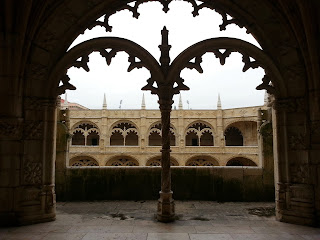Today I visit the rather grand Jeronimos Monastery and the even grander church of Santa Maria de Belem …
This huge complex is comprised of the 15th century church and monastery at the far end and at this end the Maritime Museum, the National Archaeological Museum and Planetary that were added in the early 20th century.
In 1496, King Manuel petitioned the Holy See for permission to construct
a monastery and church along the margins of the Tagus River at the entrance of Lisbon, and
the existing structure was then started that same year ( …and finished 100
years later … ). It was after the arrival of Vasco da Gama, a year later,
bringing with him samples of gold he discovered, that the monastery and the
church became a house of prayer for seamen leaving or entering port.
King Manuel I selected the religious order of Hieronymite monks to occupy the
monastery, and it was their role to pray for the King's eternal soul and to
provide spiritual assistance to navigators and sailors who departed from Lisbon
to discover the world. This the monks did for over four centuries, until 1833 when
the religious orders were dissolved and the monastery was left unoccupied.
In 1604, Philip of Spain made the monastery a royal funerary
monument, prohibiting everyone but the Royal family and the monks from entering
the building. The restoration of Portuguese Independence (1640), the monastery
regained much of its importance, becoming the burial place for royal pantheon.
The monastery withstood the 1755 Lisbon earthquake without too much
damage: only the baluster and part of the high choir were ruined, which were
quickly repaired.
On 28 December 1833 the State secularized the Jerónimos
Monastery and transferred its title to the Pious Royal House of Lisbon
to serve as a parochial church for the new civil parish of Santa Maria de
Belém. Many of the artworks and treasures were transferred to the possessions
of the crown or lost during this period. It was vacant most time and its
condition began to deteriorate until the early 20th century when the state sponsored restoration of the buildings began. The Monastery is now primarily a tourist attraction, however the church continues to function as a parish church.
The church and the monastery symbolise the Potuguese Age of Discovery
and in 1983, UNESCO formally designated the Monastery of the Hieronymites as a
World Heritage Site.
It is the most mind-boggling church interior that I have visited so far - with its amazing stone vaulted ceilings and intricately carved columns and gilded ornamentation - made even more amazing considering most of the building was constructed over 500 years ago ....



























No comments:
Post a Comment
Note: Only a member of this blog may post a comment.